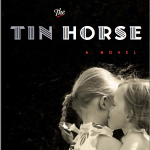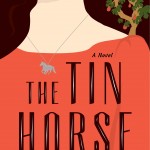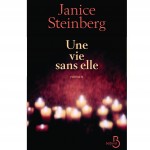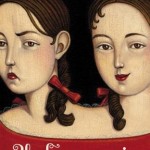 “It’s an uneasy embrace,” my editor kept saying when I voiced reservations about the first cover Random House proposed for “The Tin Horse.” Granted, I said, the photograph of two little girls hugging conveyed both closeness and tension, an ambivalence that felt just right for Elaine and Barbara, the sisters in my book. On the other hand, Elaine and Barbara are Jewish, and I’d described them as having dark wavy hair. Didn’t it seem wrong that the girls in the photo had blond straight hair? “Yeah,” my editor said. “But look at the uneasy embrace.”
“It’s an uneasy embrace,” my editor kept saying when I voiced reservations about the first cover Random House proposed for “The Tin Horse.” Granted, I said, the photograph of two little girls hugging conveyed both closeness and tension, an ambivalence that felt just right for Elaine and Barbara, the sisters in my book. On the other hand, Elaine and Barbara are Jewish, and I’d described them as having dark wavy hair. Didn’t it seem wrong that the girls in the photo had blond straight hair? “Yeah,” my editor said. “But look at the uneasy embrace.”
Often, people ask if I chose my cover. After all, it’s my book, my baby – don’t I get to dress it? Here’s a “what is behind that curtain” look at how my cover was chosen. Actually, covers, plural, since there are now four different versions for which covers have been created: U.S. (which was also used by the French publisher), Italian, German, and Dutch. (Also in the works are Brazilian, Spanish, and Japanese.)
behind that curtain” look at how my cover was chosen. Actually, covers, plural, since there are now four different versions for which covers have been created: U.S. (which was also used by the French publisher), Italian, German, and Dutch. (Also in the works are Brazilian, Spanish, and Japanese.)
My contract with Random House said I could “review” the cover. And I did get to look at cover designs. But a lot of wheels, and they’re very large wheels, get set in motion when a publisher unveils a cover. When I balked … well, imagine those wheels trying to squeal to a stop. That may sound like an outrage, but consider that this was a decision being made at a huge corporation, and multiple departments – art, editorial, marketing – had a stake in it. And it was a decision about which the professionals knew far better than I what kind of cover would stand out. Still … I asked if the image couldn’t at least be photoshopped to give them dark curly hair.
 Fortunately, the marketing department came to my rescue on the first cover. They thought it looked too dark. And, once marketing gave it a thumbs-down, the art department started over and came up with the vivid cover that pleased everyone, including me.
Fortunately, the marketing department came to my rescue on the first cover. They thought it looked too dark. And, once marketing gave it a thumbs-down, the art department started over and came up with the vivid cover that pleased everyone, including me.
As for covers in other countries… First, to clarify: Many people assume that Random House sells the book to publishers elsewhere and is involved in putting out those editions. Uh-uh. My agent, working with colleagues in other countries, sells foreign rights. I have individual contracts with those publishers, and sometimes they invite me to comment on things – in some cases, surprising things. The Brazilian publisher, for instance, kindly sent me the Portuguese translation of the book. Which was cool, but, despite being a fan of bossa nova, I don’t know any Portuguese.
 The French publisher, Belfond, did ask about the cover. They’d come up with a cluster of votive candles that looked, um, Catholic to me. I brought that up with the foreign rights person in my agent’s office, but remember those massive wheels? They turn at publishing houses worldwide. I was told that French readers would see the candles and not have any religious associations. (What do you think?) This time, my agent found the cover too dark, and Belfond went with the Random House cover.
The French publisher, Belfond, did ask about the cover. They’d come up with a cluster of votive candles that looked, um, Catholic to me. I brought that up with the foreign rights person in my agent’s office, but remember those massive wheels? They turn at publishing houses worldwide. I was told that French readers would see the candles and not have any religious associations. (What do you think?) This time, my agent found the cover too dark, and Belfond went with the Random House cover.
 The Italian and German covers feel right for their respective countries, at least for my ideas of those countries: the Italian chic, and the German, with its evidently conjoined twins, one of them quite sour-faced, reminding me of German expressionist art. By the way, you may notice the title has never stayed “The Tin Horse.” The German and Dutch versions come close, with titles that translate as “The Tin Menagerie” (German) and “The Tin Pony” (Dutch). But the Italian is “The Lying Sister.” The French edition with the candles was called “A Life Without Her,” but when they went with the bright U.S. cover, they chose “The Beautiful Promises.”
The Italian and German covers feel right for their respective countries, at least for my ideas of those countries: the Italian chic, and the German, with its evidently conjoined twins, one of them quite sour-faced, reminding me of German expressionist art. By the way, you may notice the title has never stayed “The Tin Horse.” The German and Dutch versions come close, with titles that translate as “The Tin Menagerie” (German) and “The Tin Pony” (Dutch). But the Italian is “The Lying Sister.” The French edition with the candles was called “A Life Without Her,” but when they went with the bright U.S. cover, they chose “The Beautiful Promises.”
 The latest cover, from the Dutch publisher, Artemis, arrived via e-mail a few days ago , and wow! My friend Joan Ganny, who lives in Amsterdam, calls it “een blikvanger,” an eye catcher. I love it that the girls’ faces are warm and beautiful and draw me in, yet they’re kept from looking too sweet by the startling composition and the girls’ direct, unsmiling gazes – as if they’re taking in the world and deciding what they think of it, just as I imagined Elaine and Barbara doing.
The latest cover, from the Dutch publisher, Artemis, arrived via e-mail a few days ago , and wow! My friend Joan Ganny, who lives in Amsterdam, calls it “een blikvanger,” an eye catcher. I love it that the girls’ faces are warm and beautiful and draw me in, yet they’re kept from looking too sweet by the startling composition and the girls’ direct, unsmiling gazes – as if they’re taking in the world and deciding what they think of it, just as I imagined Elaine and Barbara doing.
